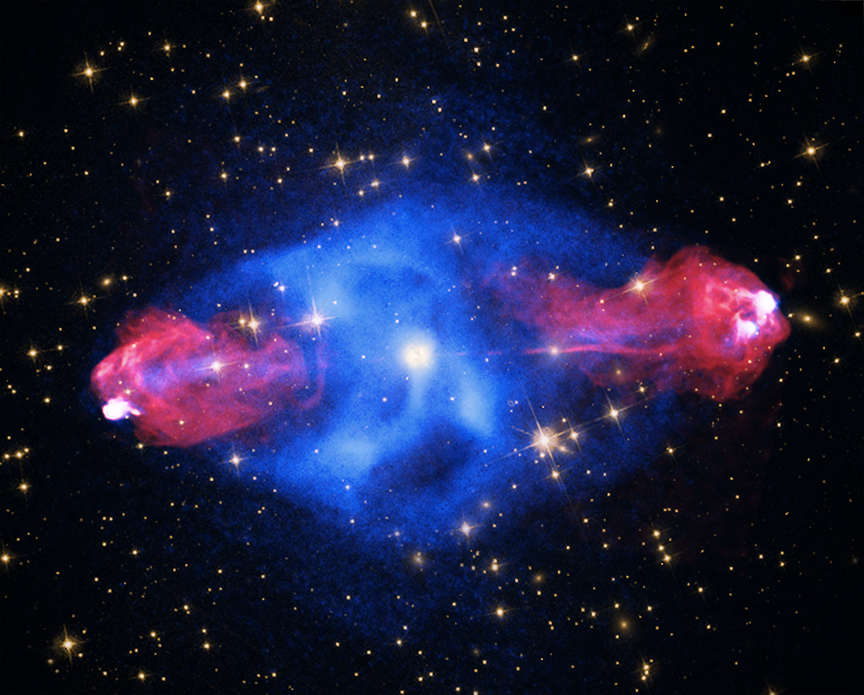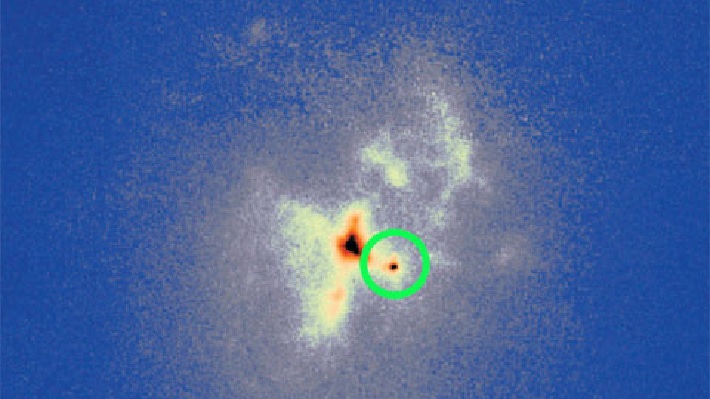A very bright something has appeared in the well-known and active galaxy Cygnus A.
Astronomers are baffled by this newly discovered mysterious object twice as bright as the brightest known supernova at these frequencies!

Last week at the American Astronomical Society meeting in Grapevine, Texas, astronomers made an announcement that’s caught the interest of several researchers: a very bright, mysterious something has appeared in a well-known galaxy.
That galaxy is the elliptical Cygnus A. Cygnus A is one of the brightest radio sources in the sky. It lies approximately 800 million light-years from us (redshift of 0.056). In its core sits a supermassive black hole madly eating and cocooned in gas, while two jets shoot out to either side and light up the intergalactic medium. This activity produces the radio radiation that makes Cygnus A so bright.
Using the recently upgraded Karl G. Jansky Very Large Array (VLA) in New Mexico, Rick Perley (NRAO) and colleagues took a gander at Cygnus A — the first time the instrument has looked at the galaxy since 1989. The new observations showed a surprise: a new, secondary object just southwest of the central black hole. This object wasn’t in the 1989 radio image. Additional, higher-resolution observations with the Very Long Baseline Array also picked up the object, clearly distinct from the galaxy’s nucleus. It’s roughly 1,300 light-years from the center.
The whatever-it-is is about twice as bright as the brightest known supernova at these frequencies. In fact, it’s much brighter than just about any transitory radio signal known, except for accreting supermassive black holes and tidal disruption events, outbursts created when a black hole eats a star.
Mystery object already spotted but forgotten
The team scoured other archives and found the object in 2003 Keck infrared observations and, more iffily, in some images from Hubble.
The science session’s attendees were aflutter with curiosity. Claire Max, who serves as director of the University of California Observatories, went back and dug through Keck data and discovered that, in fact, astronomers had already discovered this source. In 2003 she, Gabriela Canalizo (now at University of California, Riverside), and colleagues had stumbled upon the mystery source. They, too, had gone back and found it in some Hubble images and not others — they weren’t sure whether that was because the source was flickering, or just that Hubble hadn’t looked long enough to consistently see it.

The team determined that the whatchamacallit wasn’t a foreground object in the Milky Way, nor a cluster of young stars in Cygnus A. Rather, it seemed to be a compact cluster of old, red stars, with all the trappings of being the stripped-down core of a much smaller galaxy that Cygnus A had eaten. That minor merger might also explain why the big galaxy’s black hole has “turned on.”
On the other hand, Canalizo and colleagues went on to suggest in 2004 that the source might instead be a peek at the hot inner rim of the dusty doughnut enshrouding the black hole.
Perley’s team favors a merger, too. But he advocated instead that the radiation might come from a second black hole, the leftover core of the eaten galaxy. If so, then Cygnus A is one of a few galaxies that seems to host a central binary black hole.
A formal paper and press release (with cool images!) are in the works, and when they’re out we’ll update you with more info.
Papers:
Richard A. Perley et al. “Serendipitous Discovery of a Radio Transient in the Luminous Radio Galaxy Cygnus A.” 229th American Astronomical Society. Abstract 319.06.
Gabriela Canalizo et al. “Adaptive Optics Imaging and Spectroscopy of Cygnus A. I. Evidence for a Minor Merger.” Astrophysical Journal. November 10, 2003.
Gabriela Canalizo et al. “Penetrating Dust Tori in AGN.” Penetrating Bars through Masks of Cosmic Dust. 2004.












[…] Top Bishop: Europe Will Soon Be Muslim Because of Our Stupidity: SQ: AND THE SECRET CONVERSION TO ISLAM BY EUROPE’S TOP LEADERS- Brave New World: Scientists Bring About ‘Baby Farming’ and The Recreation of The Nephilim In our hedonistic age, should we really let our culture’s storytellers have access to our children? HOT TOPIC-Hacker Breaks Into Clinton Foundation Server, Finds Millions in Fraud Very bright mysterious object discovered in the active galaxy Cygnus A—-Astronomers are baffle… […]
[…] Very bright mysterious object discovered in the active galaxy Cygnus A—-Astronomers are baffle… […]
This is more fake astronomy.
“False-color infrared image” really says it all.
And “Cygnus A is one of the brightest radio sources in the sky. It lies approximately 800 million light-years from us (redshift of 0.056).”
Anyone who believes this fake science, would obviously believe anything.
True science cannot rest its conclusions on any technology that can be computer manipulated to produce data than can make or break a ruling paradigm such as Big Bangism. The stakes are too high, the temptation too great, the manipulation too easy…to allow the fox to be in charge of this hen house.
So…is Redshift Technology as applied by the Origins fixated agenda of the Space Program a fact-producing enterprise devoted to revealing truly factual (scientific) evidence about the cosmos? Or, is it merely another fraudulent use of technology that is being employed deceitfully to uphold those three essentials of the “Origins Program” and fulfill the Kabbalistic “creation” account behind them?
Even Hubble had strong doubts about astronomical redshift, favoring (or at the very least keeping open) the model where no true expansion exists, and therefore that the redshift “represents a hitherto unrecognized principle of nature.
When one recalls that the Zionist concept comes from the same mystic Kabbala as the Big Bang Paradigm, and that super-Zionist Einstein was the catalyst in finalizing monopolistic control over cosmology by Theorists (i.e., false scientists), an agenda emerges that clearly has nothing to do with true science except to distort it and use it as the perfect tool in fulfilling that all-but-hidden agenda.